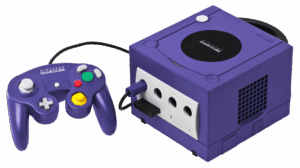
The Nintendo GameCube was a sixth-generation video game console released in 2001, succeeding the Nintendo 64. Codename “Dolphin,” it was a departure from its cartridge-based predecessor, utilizing small optical discs and focusing solely on gaming, distinguishing it from competitors like the DVD-enabled PlayStation 2. The console is remembered for its distinct, compact cube-shaped design, a great controller, and a strong library of unique first-party titles.
Technical specifications
- CPU: A 486 MHz IBM “Gekko” PowerPC processor.
- GPU: A custom 162 MHz ATI “Flipper” graphics processor, co-designed with Nintendo, capable of impressive visuals for its time.
- Media: Games were distributed on proprietary 8 cm optical discs, which had a capacity of about 1.5 GB.
- Connectivity: The GameCube included four controller ports and two memory card slots. Early models also featured a digital AV port, though this was later removed. For limited online play, a modem or broadband adapter was sold separately.
- Controller: The ergonomic controller featured a two-handled design with two analog sticks and a built-in rumble motor. In 2002, Nintendo released the WaveBird, a first-party wireless controller for the system.
Key features and accessories
- Game Boy Player: This add-on allowed users to play Game Boy, Game Boy Color, and Game Boy Advance cartridges on their television through the GameCube.
- Game Boy Advance Link Cable: Certain games could use this cable to connect a Game Boy Advance, enabling the handheld to act as a second screen or an additional controller.
- Memory Cards: With no internal storage, games were saved onto proprietary Memory Cards that came in different sizes.
- Panasonic Q: In Japan, Panasonic released a licensed hybrid version of the GameCube that included a standard DVD player.
Game library
Despite being the smallest of the sixth-generation consoles, the GameCube had a highly regarded library of titles, especially from Nintendo’s first-party studios.
- Notable exclusives:
- Super Smash Bros. Melee
- The Legend of Zelda: The Wind Waker
- Metroid Prime
- Super Mario Sunshine
- Paper Mario: The Thousand-Year Door
- Pikmin and Pikmin 2
- Animal Crossing
- Third-party support: The console also attracted strong support from third-party developers, including Sega, which ported many Dreamcast titles.
Commercial performance and legacy
- Market share: The GameCube struggled to compete with the dominance of the PlayStation 2 and Xbox. Its focus solely on games, without DVD playback, and a weak online strategy hindered its sales against competitors.
- Overall sales: With 21.74 million units sold worldwide, the GameCube underperformed Nintendo’s expectations.
- Successor: Nintendo discontinued the GameCube in 2007 to shift focus to its highly successful successor, the Wii.
- Enduring appeal: The GameCube has developed a dedicated cult following over the years, prized by retro gaming enthusiasts for its distinctive look and exceptional library of first-party and exclusive games.